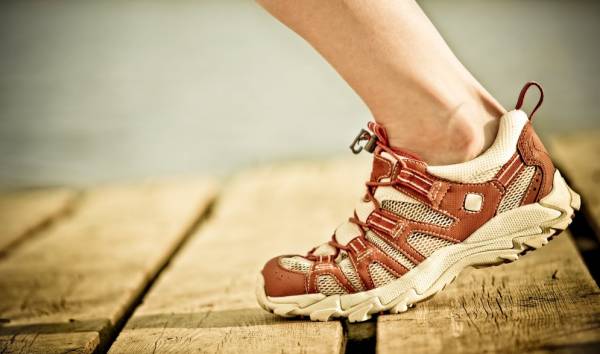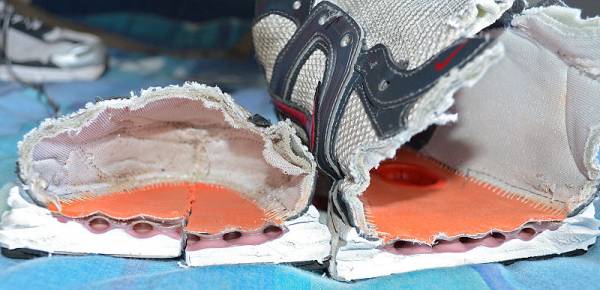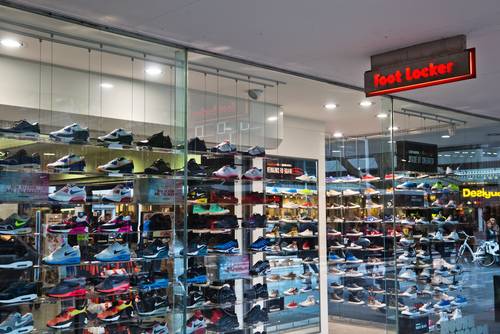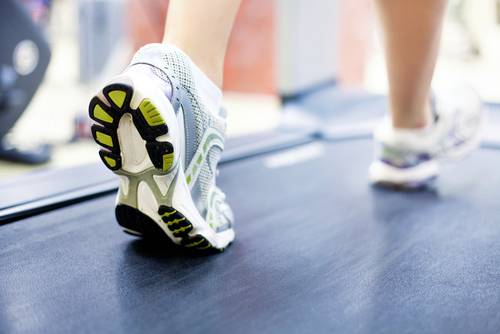A running shoe can be broken down into a few component parts. There are more and more bells and whistles appearing on shoes these days, but the basic parts remain the same.
A running shoe can be broken down into a few component parts. There are more and more bells and whistles appearing on shoes these days, but the basic parts remain the same.
The Outer Sole and the Longevity of Your Shoes
The outer sole is the bottom of the shoe. The most important function of the outer sole is grip and traction while running on varying surfaces. There’s obviously a trade-off between grip and how long a sole lasts, though.
Which leads to one of the questions I get asked most frequently: “How long does a pair of shoes last?” The answer depends entirely on how much and how often you run. While many manufacturers will make blanket statements about a shoe lasting about 500km (~300 miles), the reality is the type of surface you run on, how your shoes wear, how heavy you are, and even how far you run all have to come into consideration, so there is no simple answer.
The midsole (see below) of most shoes will generally start to wear out after around 500km, so that is a good rule of thumb to use. However, a better test is to look at the soles of your shoes regularly and look for wear. Once the pattern starts to degrade or the different sections get worn thin, then it is probably time to replace them. Another good test can simply be to put your shoes on a bench and see how flat they are or aren’t. A shoe that is close to worn out will be excessively curved up at either end.
For those wondering – 500km isn’t very long. It’s not uncommon for runners to go through a pair of shoes every two to three months if they’re logging decent miles. I know before my Ironman I was going through shoes every eight to ten weeks. While that may seem excessive, the alternative is a likely injury. So ask yourself if it’s better to spend a hundred dollars now on new shoes or spend five to ten times that amount on physiotherapy later?
The Midsole
The midsole is actually the heart of the shoe, and it’s the part you’ll notice most once you start running. This is the part of the shoe responsible for feeling soft or hard in the shoe. The main function of the midsole is to absorb the shock of the landing, whether that landing happens via heel strike or forefoot. To help with this, the midsole also acts to prevent excessive inward rotation of the ankle (pronation) as the foot lands and progresses towards a toe-off. It achieves this by flexing from a point about two-thirds from the heel, once the heel starts to come off the ground.

Older shoes were made of a compound called EVA rubber, initially developed by Brooks, which had tiny gas bubbles trapped inside the rubber. The downside to this was that after wear the gas is expelled and the EVA becomes harder and less likely to absorb compression. So if you were thinking that perhaps the best running shoes to go and buy were a pair of old-school 1970s Nikes, then think again.
A good test for a shoe’s ability to handle landing forces, or the degree to which the shoe can compress on landing, is what Tim Noakes calls the thumb test. Simply press the fingers and thumbs into either side of the midsole at both forefoot and heel. The longer the indentation lasts the softer the shoe is, and the more shock absorption it will provide. Be aware, though, this also means that the shoe will wear down faster.
Softness Versus Stiffness
A shoe is obviously a constant battle for many things. It must provide a soft ride, yet last a decent length of time. It must provide enough stiffness to help prevent any collapse of the foot or ankle, yet be flexible enough to let the foot behave as naturally as possible.
To combat this shoe manufacturers will try to use differing degrees of softness or stiffness in different areas of the shoe. The biggest problem with most shoes (and I’m yet to find one that doesn’t have this problem) is that while the mid-foot isn’t exposed to the highest forces during landing, it does experience high pressure for a much longer time.1 So it is likely that this area will wear out faster than any other area of your shoes unless you are a chronic heel striker.

In 1979 Nike came up with a solution when they introduced the Nike Air system. While this system has shown to be remarkably good at dealing with impact forces, it has also proven to be unstable in the heel. In addition, because the Air system doesn’t extend down to the forefoot these shoes still suffer from the same EVA hardening of other shoes from constant use.
Over more recent years Asics, Saucony, Reebok, Brooks, and others have all introduced so-called energy return systems into their midsoles, perhaps Asics being most notable with its gel-containing system. These systems have all proven to have at least equal performance to EVA, and many report them to be far superior.
Know Your Feet Before You Buy Your Shoes
The main thing to keep in mind, and this entails knowing and understand your individual feet very well, is that a stiff foot requires a softer midsole, while those with softer or collapsed feet (such as “flat feet”) will need a stiffer shoe.

There are several measures used inside the shoe to try to compensate for the type of foot that people have. All of these are built in to try to accomplish the exact same thing – either prevent excessive movement from people with lazy feet or try to give as much movement as possible to people with stiff feet. While it may seem overly technical, I can verify that knowing what sort of foot you have and a few details about shoe design will make buying shoes incredibly easy. Here are a few basics to know:
Slip or Board Lasting
Slip or board lasting is a process that increases a shoe’s ability to resist pronation, or collapse of the arch. When shoes are made, the nylon upper (the part that actually encases the foot) is glued directly to the midsole. If there is no additional material covering the nylon, then it is said to be slip lasted. If there is a brown-colored board that overlies a portion of the upper, then it is said to be board lasted.
Board lasting can either run for the full length of the shoe – called conventional – or it may end just behind the ball of the foot – which is called partial or combination lasting. Partial lasting can be quite useful because it doesn’t interfere with the flexibility of the forefoot while still retaining the ability to resist pronation.
If you’ve ever seen people twist a pair of runners prior to purchase this is actually the thing they’re testing for, even if they don’t really understand what it is they’re trying to achieve. A shoe that is easily twisted along its axis would be appropriate for someone with stiff feet while a shoe that is stiffer itself, and is board lasted, would be more appropriate for someone who suffers from pronation or lacks strength in the ankle.
Straight or Curved Lasts
Straight or curved lasts are designed to either give support or movement to the mid-foot. A straight-lasted shoe is one that is symmetrical around a line drawn from the middle of the shoe to the middle of the toe, when viewed from below. A straight-lasted shoe will help with ankle control by giving support to those who need it. In contrast, a curved-lasted shoe will bend inside a line draw on from the middle of the heel to the middle of the mid-foot. Curved lasting is beneficial to those needing more flexibility and softer cushioning. Usually these athletes are typified by high-arched feet and tend to wear out their shoes on the outer edges. In extreme cases, this can be seen with a slight toe-in running stance, which can lead to further problems down the track.
Heel Cups
One final piece of advice to keep in mind is that shoes tend to come with different types of heel cups. It may sound obvious, but something as simple as how wide or tall the heel cup is can have dramatic influence on your comfort when running.

The down side to this shoe selection process is that it will likely take you several attempts to find the right shoe. This is where finding a well-regarded speciality running store is vital. Many of these stores will provide a gait analysis of your running and will also have in-depth product knowledge to help you make a short list of appropriate shoes.
One final word of advice: don’t buy on price. Buy on fit and whether or not that shoe is right for you. Also, don’t feel that you shouldn’t feel tied to a particular shoe forever, especially if your goal is to build up the strength to where you can wear a minimal shoe that allows you to run as close to naturally as possible while minimizing your injury risk.
References:
1. Noakes, T., Lore of Running (Champaign, IL: Human Kinetics, 2001)
Photos 1, 2, 4 & 5 courtesy of Shutterstock.
Photo 3 by Yottanesia (Own work) [CC0], via Wikimedia Commons.






